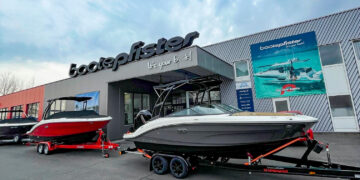Who drives along for the first time as a guest on a yacht, whether because you are invited to spontaneously spend a day together at sea or as part of a crew that has chartered a yacht, should know at least a few words from the sailing language, so that the trip succeeds and is fun. Tips from the SeaHelp editorial team for boating beginners.
So that the first trip as a guest on a yacht does not literally “fall into the water”, but becomes an all-round successful day on board, beginners should know some basic words and phrases of the sailor language; so you make yourself the stay on a sailing or motor yacht as pleasant and safe as possible, and also the other crew members and the skipper will appreciate.
Sailing language is one of the oldest technical languages in the world
In hardly any other field (except perhaps among lawyers and hunters) is there so much technical gibberish as among sailors. There is a reason for this: sailing language is probably the oldest technical language in the world, because sailboats were the first vehicles to exist, and sailing ships were for a long time the only – and largest – means of transport.
It so happens that even today sports skippers make use of numerous terms, some of them very old, which were indispensable centuries ago for safe boat handling and rapid communication on board, as well as for the exchange of experience among sailors.
When a sailor goes stern to the pier, he calls it “mooring Roman Catholic”
The first time you step onto a yacht, you will probably do so from astern, that is, from behind – at least if the boat is moored to the quay wall with its stern (the rear part of the yacht). By the way, mooring like this is called “Roman Catholic” among sport skippers. The name is said to come from the fact that this method is mainly practiced in the Mediterranean countries of Spain, Italy and France, but also often in Croatia.
Once landed on the yacht, they turn their gaze forward to the tip of the boat, which the sailor calls the bow. On board, right means starboard and left port. This is easy to remember, because the prefix “steuer” contains an “R” – the first letter of right. Or as our sailing instructor said at the time: “If I give you (as a right-hander) a slap in the face, then you have a red cheek on the port side” (port / cheek).
The small headsail is called jib on the sailing yacht, the larger aft one is called mainsail
If they are on a normal sailing yacht that is slup rigged (one mast with two sails), then the small sail in front is called jib or simply headsail, the large sail aft is called mainsail or in short: the main. With lines called halyards on board, the sails are pulled up the mast (the sails are hoisted), and with lines called sheets on a yacht, the sails are furled, depending on the wind, when the wind blows forward, or they are unfurled (opened) when the wind blows sideways or from behind (aft).
The thick wires that hold the mast in position at the sides are called shrouds, and those at the front and back are called stays (forestay at the front and backstay at the back). The little flag that is often attached to the very top of the mast (the masthead), waving merrily in the wind, is called a Verklicker by sailors – it is supposed to tell (verklickern) the helmsman which direction the wind is blowing from, so that he can adjust the sail position accordingly.
Don’t worry if the boat heels once – up to a certain point, this is normal
When there is a fresh breeze on the water, the sailing yacht (due to the wind pressure) often starts to heel (the boat tilts around its longitudinal axis), but do not worry, up to a certain point this is quite normal, the sailor says heeling (not: heeling, because it has nothing to do with an honor violation of a person). Some yachts even have a heel meter on board.
If the boat changes course and the bow goes through the wind, the sailor calls this a tack. If the stern, i.e. the aft part of the yacht, turns through the wind, it is a gybe. Good seamanship on board dictates that the helmsman (the one at the helm) announces an appropriate sailing maneuver loudly and clearly, for example, with the words “Ready to tack”, which is addressed to the operators of the sheets.
When tacking or gybing, you should pull your head in – because then the boom swings to the other side; Wahrschau! is a warning call
Then, as a novice sailor, you are well advised to keep a close eye on the main boom (the spar to which the lower part of the mainsail is attached, the front part is slung to the mast), because it is movable and swings quickly from one side to the other shortly after (other commands: “Ree” and “Over the sails”).
If someone on board shouts the word Wahrschau! to them, then he does not want to travel with them to Poland, but he wants to warn them urgently (also: Look out!, Attention! Or Keep clear off!), it is a warning call in a (supposed or actual) dangerous situation, which they should take quite seriously.
Combo, cabins, berths & Co. – This is what kitchen, rooms and beds on a yacht are called
At the rear – that is, aft – part of the sailing yacht is usually one or two steering wheels, this area is called aft cockpit or, in smaller yachts and boats, cockpit. From here you usually come towards the bow to the companionway leading down to the salon (the steps leading from the deck down to the lower deck.
In the salon there is a kitchen, which the sailor calls galley; from here also branch off the rooms (cabins) with the beds (bunks) as well as the WC’s with or without showers, which are called wet cells, only with really large yachts one speaks here of baths.
Incredible (and mostly not true): Sailor’s yarn, spun on yachts
If fellow sailors start telling incredible-sounding stories about sailing or seafaring, however, it could be hunter’s lore, referred to on board as sailor’s yarn, which is not to be taken at face value. The term derives from Schiemannsgarn, a tarred small rope used in classic shipping.
Generally speaking: don’t be afraid to ask if you don’t understand something on board. This is important (after all, it’s for their own safety to know what’s happening on board); no question is embarrassing!
What else to consider when they are on a yacht for the very first time as a guest, whether because they have been spontaneously invited on a day trip or they are part of a charter crew, our articles highlight: The first time as a guest on a sailing yacht – Ten tips for landlubbers.













